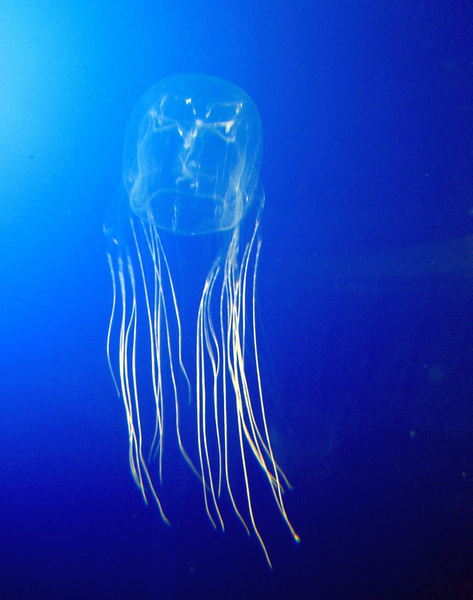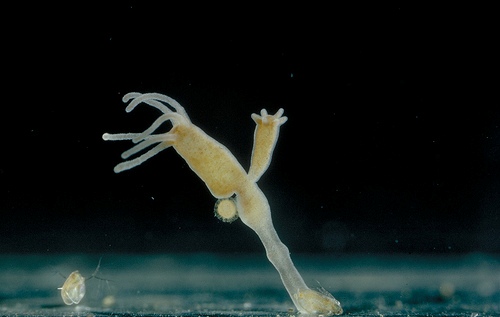Reproduction

This box jellyfish is an animal that can go undergo gametic meiosis and asexual reproduction, reproduction without sex. Let's start discussing the life cycle beginning with the mature organism. During the months of spring, the mature box jelly makes its way to a nearby freshwater river to search for a compatible mate. Once they find this mate, the female releases her eggs and the male releases his sperm into the water. However, once these jellyfish spawn they die and do not participate in the upbringing of their descendants. The egg and sperm haploid forms of the Chironex fleckeri life cycle are called gametes. Once one egg and one sperm meet, they fuse together and are a fertilized zygotic cell. This cell undergoes mitosis and forms a planulae. These planulae grow into a polyp that is approximately 1-2 millimeters in length. This polyp stage of the jellyfish usually has two tentacles attached to it. These are used to attach the polyp to any hard surface, most of the time on the underside of a crevice or somewhere else where they are not exposed to predators. While these polyps are growing, they consume plankton as their primary means of nutrition. So far we have only seen the sexual reproductive sequence of this species, but throughout the polyp stage is when this organism can undergo asexual budding.
Budding is when a new organism grows from a parent
organism. This is shown in the picture of a Chironex
relative below. The new organism is growing via mitosis, and
since this new organism is growing directly from the
parent organism, the new individual is a clone of its
parent. These parents and new polyps grow and
metamorphose into small, immature medusa. These medusa
then swim from the river back to the ocean where they
continue to grow until they reach their sexually mature
form. It takes approximately 2 months for the male and
female medusa to completely sexually mature. Once this
process is complete, the organism has 9-10 months of
free-swimming life before it swims to a freshwater
river, releases its gametes, and gives rise to another
life form. Since the box jelly released its sperm or
eggs, it dies in the river, living only for a very short
amount of time. Chironex fleckeri is considered
to be oviparous. Oviparous is a type of reproduction
where the eggs are completely discharged from the female
organism, and the growth of the new individual happens
outside of the female's body, not inside of the body
like in human reproduction.
and
metamorphose into small, immature medusa. These medusa
then swim from the river back to the ocean where they
continue to grow until they reach their sexually mature
form. It takes approximately 2 months for the male and
female medusa to completely sexually mature. Once this
process is complete, the organism has 9-10 months of
free-swimming life before it swims to a freshwater
river, releases its gametes, and gives rise to another
life form. Since the box jelly released its sperm or
eggs, it dies in the river, living only for a very short
amount of time. Chironex fleckeri is considered
to be oviparous. Oviparous is a type of reproduction
where the eggs are completely discharged from the female
organism, and the growth of the new individual happens
outside of the female's body, not inside of the body
like in human reproduction.
Now that you know how Chironex fleckeri reproduces, check out how it interacts with other organisms by visiting the Interactions page.
Are you lost? Start at the beginning by going to the Home page!
